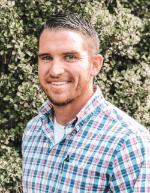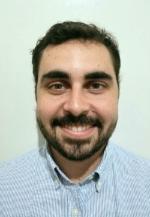Dr. Brent Sellers Current Students
Clay Cooper, MS Student
 Clay Cooper first grew up in Crystal River and moved to Lecanto during middle school. He attended the College of Central Florida in Ocala, FL and graduated with a Bachelor of Science in Agribusiness in 2016. While he was getting his bachelor’s degree Clay worked at Publix, operated a feed store, and continued working on his family cattle. Near the end of his degree he noticed a position posted for a UF/IFAS Extension program assistant in Citrus County. Citrus County had been looking for a full time extension agent for a while but had difficulty filling the position so they changed it to a program assistant position. Clay applied and got the position in 2015 while finishing his bachelor’s degree. He quickly filled in the role focusing on commercial agricultural producers, cow/calf operations, produce production and forage management. This included soil sampling, forage production assessments, weed identification and control and advice on livestock production, specifically emphasizing better management practices to improve production efficiencies. Soon after Clay graduated they re-opened the position as a full-time extension agent and he got the position. As Clay transferred into this full extension agent position most of his job duties remained the same but he was also tasked with the assisting in natural resources. This led him to get more involved in wildlife management, invasive species control and efforts to reduce water usage and improve water use efficiencies on agricultural lands.
Clay Cooper first grew up in Crystal River and moved to Lecanto during middle school. He attended the College of Central Florida in Ocala, FL and graduated with a Bachelor of Science in Agribusiness in 2016. While he was getting his bachelor’s degree Clay worked at Publix, operated a feed store, and continued working on his family cattle. Near the end of his degree he noticed a position posted for a UF/IFAS Extension program assistant in Citrus County. Citrus County had been looking for a full time extension agent for a while but had difficulty filling the position so they changed it to a program assistant position. Clay applied and got the position in 2015 while finishing his bachelor’s degree. He quickly filled in the role focusing on commercial agricultural producers, cow/calf operations, produce production and forage management. This included soil sampling, forage production assessments, weed identification and control and advice on livestock production, specifically emphasizing better management practices to improve production efficiencies. Soon after Clay graduated they re-opened the position as a full-time extension agent and he got the position. As Clay transferred into this full extension agent position most of his job duties remained the same but he was also tasked with the assisting in natural resources. This led him to get more involved in wildlife management, invasive species control and efforts to reduce water usage and improve water use efficiencies on agricultural lands.
To maintain his position as a UF/IFAS Extension Agent for Citrus County, Clay needed to earn his Master’s degree. Clay had worked with Dr. Sellers previously on weed identification and management. While visiting the RCREC one day for an event he ended up sitting next to Dr. Sellers and they began discussing different program opportunities for a master’s degree at the center. Shortly after, Dr. Sellers attended a pasture management program Clay was hosting and they talked more about major weeds affecting Florida cattleman. Clay had recently met with some local cattleman and they communicated that they were having big issues with a weed called brunswickgrass, also referred to as brown seeded paspalum.
At the time there was little to no data on how to manage this weed in pastures. Dr. Sellers came for a site visit near Clay and saw how big of a problem brunswickgrass was to bahiagrass pastures and livestock producers. Clay and Dr. Sellers came to the conclusion that data needed to be collected on this pasture weed and it would be fitting for a master’s research project. Clay started as a master’s student under Dr. Sellers in the fall of 2018.
Clay’s research will focus on investigating management strategies for controlling brunswickgrass in bahiagrass seed production fields in Florida. He will be conducting trials examining annual forage rotations, herbicide titrations, application timings and the impacts of rainfall. The annual forage rotation part involved applying glyphosate to a study pasture and then prepping and planting warm season annuals to see if they could hold back brunswickcgrass regeneration. After the forage rotation study, a local producer contacted Clay about using hexazinone to control smutgrass and seeing an impact on brunswickgrass. So Dr. Sellers and Clay decided to see if and at what application rate hexazinone would provide adequate control of brunswickgrass. They applied hexazinone at ½, 1, 2, 3, and 4 pints to see what rate was effective at controlling brunswickgrass. They also wanted to examine the timing of applications using hexazinone, as commercial applications were applied in April and by mid-Summer showed significant regeneration. They tried applications later in the year, May-September and attempted to narrow down the application rate and time of application monthly to find the most effective treatment. From seeing better results of hexazinone application later in the season they also chose to conduct a rainfall stimulation study to assess what affect rainfall had on treatment.
When Clay is not working as an extension agent he still enjoys hunting, fishing and just about anything outdoors.
Seth Oren, MS Student (non-thesis)
Seth is from Edgerton, WI and he previously attended University of Wisconsin - Platteville
Caetano Augusto Rossi Sales, MS Student
 Caetano is originally from Berkeley, California but lived most of his life in Goiânia, Brazil. Graduated with a Bachelor’s degree in Agronomy at Sao Paulo State University (Universidade Estadual Paulista – UNESP). As an undergraduate he was an intern at LAPDA – Laboratório de Plantas Daninhas, the weed science laboratory of the university, under the supervision of Dr. Pedro Luis da Costa Aguiar Alves. He also had the opportunity to work abroad at N. Casertano Greenhouses & Farms in the state of Connecticut, USA.
Caetano is originally from Berkeley, California but lived most of his life in Goiânia, Brazil. Graduated with a Bachelor’s degree in Agronomy at Sao Paulo State University (Universidade Estadual Paulista – UNESP). As an undergraduate he was an intern at LAPDA – Laboratório de Plantas Daninhas, the weed science laboratory of the university, under the supervision of Dr. Pedro Luis da Costa Aguiar Alves. He also had the opportunity to work abroad at N. Casertano Greenhouses & Farms in the state of Connecticut, USA.
In January 2020, he began his undergraduate internship, here at UF/IFAS Range Cattle REC, where he spent six months advised by Dr. Brent Sellers on research with pasture and rangeland weed management.
In August 2020, Caetano started his Master’s degree in Weed Science at the University of Florida, advised by Dr. Brent Sellers. Caetano’s research interests include studying the impacts of florpyrauxifen-benzyl on weed control and forage tolerance in Florida grazing lands.
